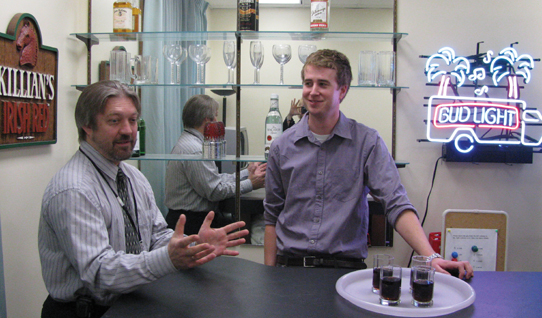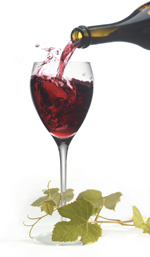|
By
Dawn
Brazell
Public Relations
Not many bartenders would
want the job at MUSC's Human Bar Laboratory. The tips are lousy,
actually non-existent, and there's only one customer at a time.
Mark Ghent, however, likes
the job in the Center for Drug and Alcohol Programs' (CDAP) bar
laboratory where he serves as program coordinator. It's all for a good
cause in the name of ongoing research into the rapidly changing field
of alcohol addiction and treatment.
 Dr. Konstantin Voronin, left, and
Mark Ghent discuss how studies are set up in the MUSC's Human Bar
Laboratory. Dr. Konstantin Voronin, left, and
Mark Ghent discuss how studies are set up in the MUSC's Human Bar
Laboratory.
The cornerstone of CDAP is
the Charleston Alcohol Research Center, one of only 15 such centers
nationally that is funded by the National Institutes of Health (NIH).
Tucked away within MUSC's
Institute of Psychiatry is a tiny room that houses the Human Bar
Laboratory. 'Customers' visiting the bar get to hang out for a whole
day in the mirrored, neon setting. Here, customers get a $16 bar
credit, which if not spent, gets added to the $300 to $360 they will be
receiving for participating in this particular clinical research study.
Not the best business
practice of a successful bar but it is the perfect setting for a lab
that seeks to shed light on how to better customize alcohol treatment
based on a person's characteristics and genetics. The current customers
have been screened for alcohol dependence and impulsivity and provide
blood for DNA analysis.
Konstantin E. Voronin,
M.D., Ph.D., and a research assistant professor in the Department of
Psychiatry and Behavioral Sciences, said the bar laboratory is an
important tool to assess the effectiveness of medications that earlier
studies suggest may be effective in reducing alcohol craving in humans.
 Although red wine isn't served in
MUSC's Human Bar Laboratory, it is the drink of choice for many. Visit http://www.alcoholanddrugabuse.org
for the latest on facts about research and prevention. Although red wine isn't served in
MUSC's Human Bar Laboratory, it is the drink of choice for many. Visit http://www.alcoholanddrugabuse.org
for the latest on facts about research and prevention.
The current eight-day
study: Impulsivity and drinking/craving:
effect of a dopamine stabilizer medication, also includes fMRI or
functional magnetic resonance imaging. By taking pictures of brain
activity associated with alcohol taste and picture induced craving,
this part of the study examines how the medication aripiprazole might
affect the activity and thereby its potential for reducing alcohol
cravings.
The bar- lab enables
researchers to quickly translate any promising results in animal
studies into clinical trials to benefit people. CDAP Director Raymond
F. Anton, M.D., a Distinguished University Professor in the Department
of Psychiatry, said the center has been doing translational research
for 15 years, long before it became the buzz word in medical research
circles.
It's one reason
CDAP's alcohol research center recently received its fourth NIH renewal
for a five-year grant, receiving $1.6 million per year from
2011-2016 from the National Institute of Alcohol Abuse and
Alcoholism. CDAP also was named in the 2011 U.S. News and World
Report as one of the top ten best graduate addiction programs.
 Dr. Raymnd Anton Dr. Raymnd Anton
Anton said it's an
exciting time to be in the field.
"It's really
high-level science. It's like competing in the Olympics. We're
competing against the best people in the country for funding of the
work that we do. We have to impress our scientific colleagues that our
work is novel, exciting and scientifically important, and they are very
discriminating judges."
Personalized Medicine
One focus for the next
five years is what causes people to evolve from being social drinkers
to becoming alcohol dependent. Researchers are studying brain
neurochemicals at various stages of the development of dependence to
see how they might change. "These are the same chemicals like dopamine
that drugs such as aripiprazole would work on, so it's all tied
together—the drinking behavior, the brain chemistry and the
pharmacology to reverse the alcohol-induced changes," Anton said.
Researchers use
brain imaging as a tool to see how genes may predict a person's
response to alcohol and medication treatment, such as MUSC's clinical
trial on the medication Naltrexone that blocks an opiate receptor in
the brain and was found to be very effective for about 20 to 25 percent
of alcoholics, he said.
"If people have a
certain genetic propensity—it really comes down to just one nucleic
acid being different in an opiate gene that's called a SNP or a single
nucleotide polymorphism—there's actually evidence they are more
sensitive to the endorphin effects of alcohol. We think that these
might be the people who respond to Naltrexone better because it blocks
the endorphin from binding to that receptor and they might get less
pleasure from alcohol and less craving."
Interestingly, 25 percent of Caucasians have that SNP or polymorphism,
he said.
"Not every alcoholic
is like every other alcoholic. Some might have this opiate gene
problem. Another person might have dopamine gene problems. Another
person may have impulsivity. Another person might have social anxiety.
The idea is to try to slice the reasons why people drink into smaller
groups so we can direct our treatment more specifically to the exact
reasons why people are drinking."
This is a form of
personalized medicine that is being applied to alcohol dependence. Two
other areas of interest are the impact of having social anxiety or
childhood trauma and what that connection might be in the development
of alcohol dependency. Researchers want to know if they can treat a
person's social anxiety to relieve the stress that may lead these
people to become alcohol dependent and explore the genetic risk and
gene changes that happen in the brains of people who have had childhood
trauma that may influence the development of alcoholism later in life,
he said.
"Does alcohol
provide more of a stress reduction effect for those people? If we can
make that link, then it could become very important in evaluating
people for their history of trauma and stress responsivity. You might
want to treat them completely different. You might want to put them on
an anti-depressant— something to stabilize their serontonin
system—which we know is affected by early childhood trauma."
Since April is alcohol
awareness month, Anton wants to spread the message of the role of
alcohol—both good and bad—in people's lives.
"Not all alcohol is bad.
It has some positive health
consequences when
used in moderation. But for those particularly at risk because they
have a different biology or family genetic structure, it can become
excessively bad pretty quickly."
Timely Treatment
One goal of CDAP is to
raise awareness about research advances, in part to shorten the typical
10-20-year lag time that exists between when people meet the criteria
for alcohol dependence and when they seek treatment. During that time
period, the brain gets changed quite a bit to the point that it's much
more resistant to treatment. Because alcohol is a legal drug, the issue
can get overlooked, said Anton.
"There's much more
health care dollars and social costs to heavy alcohol use than cocaine
or heroin. "
Alcohol plays a role
in a considerable number of other diseases—including increased risk for
heart disease and stroke, some cancers and high blood pressure. Even
depression and anxiety might be rooted in excessive alcohol use. He and
other scientists give community talks, including ones at area schools,
to teach the public about safe amounts of consumption and to encourage
early treatment for those who suspect they drink too much or may be
becoming dependant.
For ethical reasons,
researchers have designed the clinical studies in the human bar lab to
accept non-treatment seeking individuals who meet the criteria for
alcohol dependence. Voronin said they wouldn't want to serve drinks to
individuals interested in receiving treatment since that could impede
their progress.
For someone who has
no interest in getting treatment, though, the human bar lab lets
researchers do valuable research and raise awareness. He does
motivation enhancement therapy at the end of the eight-day study to let
participants know just how much they drink, how it compares to national
rates and, projected out, what that means for their health.
"Many of them are
surprised about it, and they start to think about it," he said.
Voronin said it's an
important chance to plant a seed, and they let them know the myriad of
treatment options that now exist. The older participants sometimes have
gotten to a point where they can see how alcohol is interfering with
their lives—whether at home, work or socially—and affecting their
health.
"If they feel this
way, they need to do something as soon as they can because it gets
harder later. We don't push them, but we open all the doors."
How
Much is Enough?
Unhealthy drinking is more than four drinks in one setting or 14 drinks
in one week for men and more than three drinks in one setting or seven
drinks in one week for women.
For an online screening,
visit http://www.muschealth.com/cdap/. For a
speaker on the latest research, call Sylvia Rivers at 792-9531 or
e-mail riverssy@musc.edu.
|



 Dr. Konstantin Voronin, left, and
Mark Ghent discuss how studies are set up in the MUSC's Human Bar
Laboratory.
Dr. Konstantin Voronin, left, and
Mark Ghent discuss how studies are set up in the MUSC's Human Bar
Laboratory. Although red wine isn't served in
MUSC's Human Bar Laboratory, it is the drink of choice for many. Visit
Although red wine isn't served in
MUSC's Human Bar Laboratory, it is the drink of choice for many. Visit 